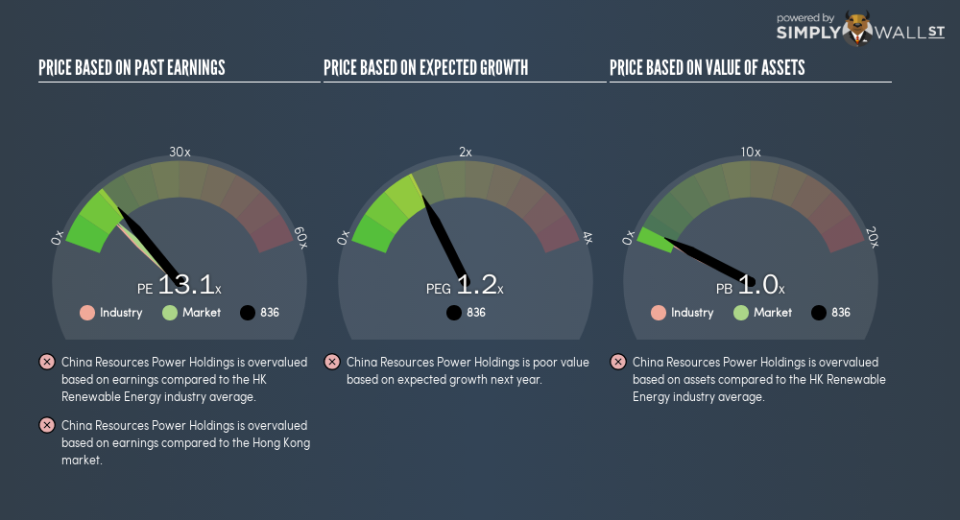Here’s What China Resources Power Holdings Company Limited’s (HKG:836) P/E Is Telling Us

This article is written for those who want to get better at using price to earnings ratios (P/E ratios). To keep it practical, we’ll show how China Resources Power Holdings Company Limited’s (HKG:836) P/E ratio could help you assess the value on offer. Based on the last twelve months, China Resources Power Holdings’s P/E ratio is 13.09. That corresponds to an earnings yield of approximately 7.6%.
See our latest analysis for China Resources Power Holdings
Want to help shape the future of investing tools and platforms? Take the survey and be part of one of the most advanced studies of stock market investors to date.
How Do You Calculate China Resources Power Holdings’s P/E Ratio?
The formula for P/E is:
Price to Earnings Ratio = Price per Share ÷ Earnings per Share (EPS)
Or for China Resources Power Holdings:
P/E of 13.09 = HK$15.7 ÷ HK$1.2 (Based on the year to June 2018.)
Is A High Price-to-Earnings Ratio Good?
A higher P/E ratio implies that investors pay a higher price for the earning power of the business. That isn’t necessarily good or bad, but a high P/E implies relatively high expectations of what a company can achieve in the future.
How Growth Rates Impact P/E Ratios
When earnings fall, the ‘E’ decreases, over time. That means even if the current P/E is low, it will increase over time if the share price stays flat. A higher P/E should indicate the stock is expensive relative to others — and that may encourage shareholders to sell.
It’s nice to see that China Resources Power Holdings grew EPS by a stonking 36% in the last year. In contrast, EPS has decreased by 17%, annually, over 5 years.
How Does China Resources Power Holdings’s P/E Ratio Compare To Its Peers?
The P/E ratio essentially measures market expectations of a company. The image below shows that China Resources Power Holdings has a higher P/E than the average (9.6) P/E for companies in the renewable energy industry.
Its relatively high P/E ratio indicates that China Resources Power Holdings shareholders think it will perform better than other companies in its industry classification. Shareholders are clearly optimistic, but the future is always uncertain. So further research is always essential. I often monitor director buying and selling.
Don’t Forget: The P/E Does Not Account For Debt or Bank Deposits
Don’t forget that the P/E ratio considers market capitalization. That means it doesn’t take debt or cash into account. Hypothetically, a company could reduce its future P/E ratio by spending its cash (or taking on debt) to achieve higher earnings.
Such spending might be good or bad, overall, but the key point here is that you need to look at debt to understand the P/E ratio in context.
How Does China Resources Power Holdings’s Debt Impact Its P/E Ratio?
Net debt totals a substantial 140% of China Resources Power Holdings’s market cap. This level of debt justifies a relatively low P/E, so remain cognizant of the debt, if you’re comparing it to other stocks.
The Bottom Line On China Resources Power Holdings’s P/E Ratio
China Resources Power Holdings’s P/E is 13.1 which is above average (10.3) in the HK market. While the meaningful level of debt does limit its options, it has achieved solid growth over the last year. It seems the market believes growth will continue, judging by the P/E ratio.
When the market is wrong about a stock, it gives savvy investors an opportunity. People often underestimate remarkable growth — so investors can make money when fast growth is not fully appreciated. So this free report on the analyst consensus forecasts could help you make a master move on this stock.
But note: China Resources Power Holdings may not be the best stock to buy. So take a peek at this free list of interesting companies with strong recent earnings growth (and a P/E ratio below 20).
To help readers see past the short term volatility of the financial market, we aim to bring you a long-term focused research analysis purely driven by fundamental data. Note that our analysis does not factor in the latest price-sensitive company announcements.
The author is an independent contributor and at the time of publication had no position in the stocks mentioned. For errors that warrant correction please contact the editor at editorial-team@simplywallst.com.

 Yahoo Finance
Yahoo Finance 
